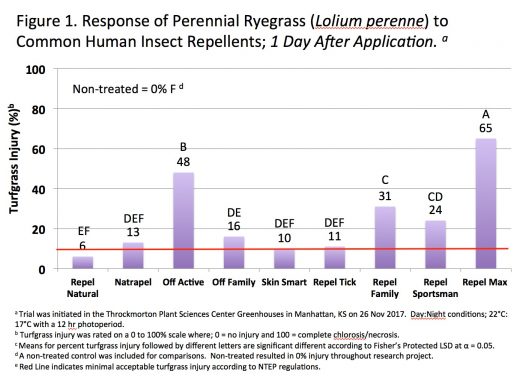The Effect of Human Insect Repellents on Perennial Ryegrass (Lolium perenne) Growth and Recovery
(By Jared Hoyle, KSU Turfgrass Research and Extension and Peyton South, KSU Turfgrass Undergraduate Research Assistant)
Summary. Turfgrass damage has been observed from misapplications of human insect repellents. Minimal research has been conducted to determine the cause of the damage. Greenhouse research trials were conducted to survey various human insect repellents on turfgrass growth and recovery. Insect repellents resulted in a wide range of damage. No common trend was observed although research trial shows possible repellents to be utilized around turfgrass that will minimize turfgrass injury.
Rationale. Human insect repellents containing diethyltoluamide (DEET) commonly damage turfgrass due to non-target application. Common visual damage results in two areas of healthy growing turfgrass in the shape of footprints with necrotic and chlorotic turfgrass surrounding. Damage results in unacceptable turfgrass quality and playability. Minimal research has been conducted to explore the influence of human insect repellents on turfgrass injury and recovery.

Objectives. Evaluate the influence of human insect repellants on Perennial Ryegrass (Lolium perenne) growth and recovery.
Study Description. Research trials were initiated in November of 2016 at the Throckmorton Plant Sciences Center Greenhouses in Manhattan, KS to determine the influence of human insect repellents on perennial ryegrass (Lolium perenne) growth and recovery. Perennial ryegrass was established in 10 by 10 cm pots at 387 kg ha-1, maintained at 4.4 cm and were irrigated to prevent drought stress. Greenhouse environment was a 12 hr photoperiod at 15.5°C/ 22.2°C (night/day). Insect repellent treatments were applied to perennial ryegrass plants arranged in a randomized complete block design with 4 replications. Treatments included 9 insect repellents and a non-treated control for comparison (Table 1). Five treatments contained the active ingredient DEET. Other commonly used insect repellents were also included for comparison. Collected data included visual percent injury on a 0%- 100% scale, where 10% represented maximum acceptable injury. Data was subjected to ANOVA in SAS and means were separated according to Fisher’s protected LSD at 0.05 significance level.
Results. All treatments except the control resulted in at least 6% turfgrass injury 1 day after application (DAA). Repel Max (40% DEET) and Off Active (15% DEET) resulted in 68% and 30% injury, respectively 21 DAA. At 21 DAA all other treatments resulted in turfgrass injury similar to the non-treated. Insect repellants with the same active ingredient percentage resulted in various perennial ryegrass injury and recovery. Although no different in % DEET, Off Active and Off Family resulted in 30% and 0% injury, 21 DAA, respectively. Results also demonstrate that permanent non-target turfgrass injury could occur if Off Active and Repel Max are applied as a human insect repellent. Further greenhouse and field trials are needed to confirm results as well as determine if other non-labeled ingredients influence turfgrass injury.
Always remember to READ THE LABEL for the correct rate, turfgrass tolerance, and specific instructions before application!!!
***Mention of trade names or commercial products in this article is solely for identification purposes and does not imply recommendation or endorsement, nor is criticism implied of similar products not mentioned by Kansas State University.***
Don’t forget to follow me on twitter @KSUTurf.
Also, visit our facebook page www.facebook.com/KSUTurf




